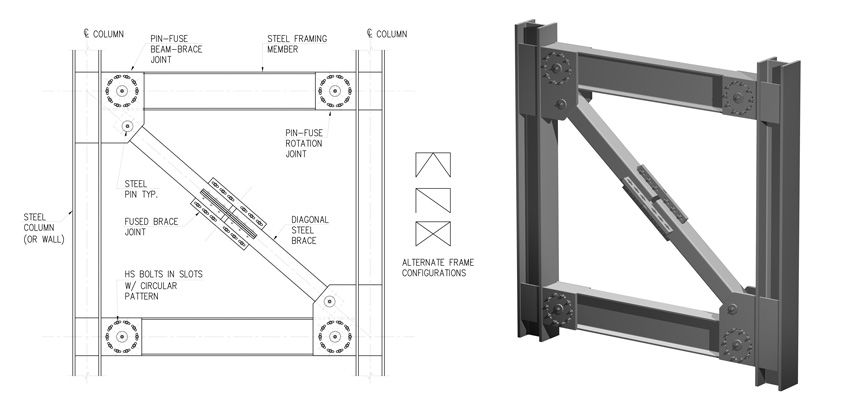The Core of the Matter
Pin-Fuse Frame
Another interesting development for strengthening the core is the pin-fuse frame, innovated by SOM. The patented friction-fuse system essentially combines the stiffness and efficiency of braced frames with the ductile behavior of moment frames with beam-columns and brace “fused” joints that slip in friction at preset force levels.

Images courtesy of SOM
Contributing to the growing selection of steel-braced core innovations, SOM’s pin-fuse frame is a patented friction-fuse system, which combines the stiffness and efficiency of braced frames with the ductile behavior of moment frames. Beam-columns and brace “fused” joints slip in response to friction at preset force levels that work to strengthen the building core.
Connected with bolts containing a friction surface, Sarkisian explains that in response to a seismic event, the brace starts to slide, thereby creating heat and slowing down the momentum. “We think the technology has a lot of promise, particularly in earthquake-prone regions,” he says. We’re finding huge interest, driven by recent earthquakes and people’s interest in getting back into their [undamaged] buildings after an earthquake.”
The system essentially achieves energy dissipation without yielding primary structural elements to drift levels of at least 4 percent, thereby reducing post-earthquake repair costs. While the technology’s friction-slipping characteristics work to dissipate energy in major seismic events, they remaining fixed in wind and minor seismic events.
Furthermore, the pin-fuse frame locks elastic strain energy into the structure that can be recovered to re-center the building following a major seismic event.
As reported in the “Pin-Fuse Frame: Full Scale Tests” white paper prepared for the Structural Engineers Association of California and authored by Sarkisian—along with a couple of his SOM colleagues and researchers from the University of California, San Diego— analysis studies indicate that the system behaved satisfactorily under design ground motions, and in several performance aspects, it was superior to conventional reduced beam section moment connections.
Choosing Steel
While steel-braced cores continue to gain traction, Santi points out that steel framing requires more skilled labor, and in some cases, that expertise is simply not available in many parts of the world where tall buildings are being built.
That said, he predicts that “as regions are further developed and as they become more sophisticated, steel construction will probably become more and more viable.” Furthermore, as an alternative to the very high carbon emissions associated with cement production, Santi further anticipates that the pendulum will swing back toward predominantly steel-framed tall buildings.
At the same time, while steel-braced cores may be ideal for many buildings, in some cases, a steel perimeter system might make more sense, or perhaps a planar system between the core and the perimeter.
Regardless, Jackson remarks that steel remains the material of choice for office and retail spaces that prefer long spans and the easier ability to make future modifications and openings.
Sarkisian adds that buildings simply adhering to the building code will likely experience damage requiring major replacement in the event of an earthquake. “The use of steel really helps with both performance and long-term cost benefits. I think the popularity of the material with increase over time.”
Ultimately, Hooper remarks that he is very supportive of architects becoming more aware of the different structural options that are available. “The more architects know, the easier it is for us, as structural engineers, to explain things to them and discuss these options.”
Barbara Horwitz-Bennett is a trade press journalist who has covered the design and building industry for the past 17 years. She contributes regularly to a number of leading architectural publications.

|
The Steel Institute of New York is a not-for-profit association created to advance the interests of the steel construction industry by helping architects, engineers, developers, and construction managers develop engineering solutions using structural steel construction. www.siny.org |








